From DSLRs, mirrorless cameras, to the iPhone, it’s easier than ever to find a digital camera and start taking great photos. We’ve compiled a list of the ten different types of cameras most photographers use.
This article applies to all types of photographers – beginner, casual, or professional. We hope this article inspires you to look deeper at the various cameras and find one that best suits you!
Here is an infographic highlighting the 10 main camera types discussed in this article.

What are the main types of cameras used for photography ?
There are many different types of cameras out there, and the main ones you’ll find are:
- DSLR cameras
- Mirrorless cameras
- Bridge cameras
- Compact digital camera
- Film cameras
- Action cameras
- 360 cameras
- Smartphone cameras
- Instant cameras
- Medium format cameras
Each type of camera has its pros and cons. We’re not out to convince you to purchase a specific style, but to give you information that will help you choose one that you’ll love using the most. Read on to learn more in greater detail and what you’d expect from each one.
1. DSLR Cameras

DSLR stands for “Digital Single Lens Reflex”. If you’re looking to take your
When you look through the viewfinder of a DSLR, you’re seeing through the lens with the help of a mirror and prism. These are inside the camera body and allow you to view images the right way up. When you take a photo, the mirror flips up so light enters through the shutter and reaches the sensor.
DSLRs range in price and quality. If your budget and enthusiasm are up for it, the sky’s the limit. Top of the line DSLRs are heavy-duty pieces of camera equipment built for rugged use. The camera bodies are weather-sealed so they can withstand harsh conditions. They’re often favored by news and sports photographers.
High Quality DSLR Images
DSLR cameras produce high quality looking images. They give you the ability to control your
Of all the types of cameras, DSLRs have the biggest range of lenses available. From extreme wide-angle to massive telephoto lenses, there are many options. Both prime lenses, that don’t zoom, and zoom lenses are available to suit your needs. There are also many types of specialty lenses such as:
- Macro lens
- Tilt-shift lens
- Lensbaby lens
- Fish eye lens
There are two main types of DSLR cameras. Full frame and crop sensor. Full frame cameras have a sensor the same size as a single 35mm film camera. Crop sensor models have a smaller sensor size, but these are still much larger than sensors in compact cameras and phones.

The two most popular brands of DSLRs are Canon and Nikon. These two companies have been around for a very long time, and compete for the top spot in the DSLR market. There are pros and cons to both brands. You’ll find photographers who swear by the cameras they use, regardless of brand. Each has an extensive range of cameras to choose from.
A few other companies make DSLR cameras, but the range of lenses they produce is limited.
Pros:
- Ability to control all settings
- Many lens options
- HD video
- Optical viewfinder
- Customizable
Cons:
- Can be on the bulky, heavier side
- High price point
- Semi steep learning curve
2. Mirrorless Cameras

Digital mirrorless cameras, as the name suggests, have no mirror. What you see when you look through the viewfinder is a small electronic screen. This displays what you are pointing your lens at.
In recent years, mirrorless cameras have gained popularity. People love them because they are smaller and lighter than many DSLR cameras with no less quality.
Like DSLRs, mirrorless cameras come with full-frame or crop sensors. There is no difference in image quality between DSLR and mirrorless cameras with comparable sensors.
Many photographers who switch from DSLR to mirrorless struggle with the electronic viewfinder. Seeing a digital image, rather than seeing optically through the lens, is challenging. The image looks different, but there’s also more information available. Focusing and metering are often enhanced with an electronic viewfinder.
As far as lens mount and image quality, however, they are both equally competitive. Mirrorless cameras have a growing range of lenses available. It’s often possible to use lenses from other camera manufacturers. For some third-party lenses, you will need an adaptor, whereas for others you will not, depending on the brand of camera and lens.

Sony championed the first full-frame mirrorless cameras. Fujifilm, Olympus and Panasonic also produce high-quality mirrorless cameras. Both Canon and Nikon were slower to enter the market for this type of camera, but now both have various models.
Due to their more compact size, mirrorless cameras have smaller batteries. These may not last you a full day, so it pays to pick up a few spares if you plan on buying a mirrorless camera.
Pros:
- Lighter and more compact than DSLRs
- Full settings control
- Interchangeable lenses
- High-res images and amazing sharpness
- Attractive build quality and aesthetic
- High-res video capabilities
Cons:
- Electronic viewfinder
- Can be laggy and slow
- Fewer gear and accessories
- Shorter battery life
3. Bridge Cameras

A bridge camera is chosen by many people when they get more serious about
At a glance, a bridge camera with a viewfinder looks like a DSLR camera. However, despite their likeness, there are significant differences. They are smaller, lighter, and easier to handle. Picking up your first bridge camera can be an ideal way to embark on developing your love for
Bridge cameras fill the gap in quality between phones and compacts, and are the first two types of camera on our list. The size of the sensor is not as big as in most DSLRs and mirrorless cameras. It is though, bigger than you’ll find in compact cameras and phones.
It has a fixed lens. You cannot swap it out for another lens. All bridge cameras have zoom lenses. The higher end models have zooms with incredible ranges, from very wide to ultra telephoto.
Pros:
- Small and light
- Easy to use
- Versatile zoom lenses
- Affordable
- Reasonable size sensor
Cons:
- Lens quality
- Battery life
- Lower image quality than mirrorless or DSLR
- More difficult to control manually
4. Compact Cameras

Compact cameras are small and designed to be easy to use. It is often called a point-and-shoot camera because it is so quick and easy to take photos with.
Everything is automated, so you don’t have to pay much attention to capturing an image. If you want something of an upgrade from your phone, but don’t want to carry a larger camera, this is the type of camera for you.
Depending on your budget, there are some very basic and advanced point-and-shoot cameras. They range in size. Smaller than your phone to a little larger, but will still fit comfortably in your pocket or purse.
Sensor sizes are smaller, but not so small as in most phones. One big advantage a compact camera has over a phone is the zoom lens. Having an optical zoom lens gives you more flexibility and convenience than your phone.
Pros:
- Incredibly easy and user-friendly
- Affordable
- Zoom lens
- No need to change the lens
- Small and lightweight
Cons:
- Limited settings and features
- Small sensor
- Lower resolution
5. Film Cameras

Film is not dead. Many beginner photographers are using film cameras to develop their style and skills. Many experienced photographers prefer the look and feel of photos taken with film.
The main difference for digital photographers who pick a film camera is the lack of a screen. Using film, you have to learn to be patient. You also need to be more sure of your settings because you won’t know if you get something wrong until your film comes back from the lab.
This can certainly help hone your skills. Taking time to understand what you’re doing while using film is a good challenge.
Most film cameras work the same way DSLR cameras do. Range finder film cameras are like mirrorless cameras, but without an electronic viewfinder or screen. They all have a lens and a shutter to control the light. The film you load determines the ISO.
New film cameras are not so common. There are many types of second-hand film cameras available. They include compacts, SLR, medium format, and large format cameras that use sheet film.
Pros:
- It’s authentic and vintage
- Inexpensive, quality lens
- Great image resolution
- Affordable
Cons:
- Steep learning curve
- Film costs can be high
- No monitor
6. Action Cameras

For the adventure seekers and adrenaline junkies, action cameras are a no-brainer. Action cameras are perfect for the outdoors. They can withstand rough weather conditions, they’re shockproof, lightweight, and highly durable.
This type of small action camera includes 4K video, screens, and high FPS rates. Choosing the right action camera will depend on what you’re planning to use it for. But most of the action cameras available have similar features.
The GoPro Hero camera series is the most popular. This is one of the original action cameras. They continue to develop designs, adding new features to imporve user experience. Other brands you may want to explore are Sony RX0, DJI Osmo, and SJCAM SJ8.
Pros:
- Super lightweight and durable
- Can be mounted and fixed anywhere
- Weather-proof and versatile
- High-quality resolution in a small body
Cons:
- Small sensor
- No manual focusing
- No viewfinder (usually)
- Few settings and customizations
- Poor battery life
7. 360 Cameras

360-degree cameras are becoming more and more popular and for good reason. They produce gorgeous, realistic-looking panoramic photos that are perfect for the outdoor photographer. Many of them are like action cameras, being able to withstand rough conditions and are weather resistant.
Some knowledge of image stitching will help you produce amazing photos using a 360-degree camera. In a single click, the camera will capture an entire 360-degree view. This makes it a great choice for travelers, hikers, and adventurers.
A few popular choices for 360 degree cameras include GoPro Fusion, Samsung Gear 360, Rico Theta 5, Insta360, and the GoPro Max.
Pro:
- Lightweight and easy to carry
- Can be mounted anywhere
- Allows live streaming/live view
- Produces realistic images
Cons:
- Lower resolution images
- Sensitive to motion blur and camera shake
- Can be challenging to frame shots
- Cannot be printed
8. Smartphone Cameras

You know what they say, “The best camera is the one you have with you”. There’s no doubt that the smartphone camera has been the widespread choice of
Storing all your photos in your device and having the option to upload them immediately also appeals to many people. You can capture all the candid moments, landscapes, and portraits without much effort. With new iPhones and Androids coming out every year, the quality of smartphone cameras has improved dramatically.
Another cool addition to smartphone
Pros:
- Small, lightweight, and versatile
- Convenience
- Easy storage and cloud backup
- Add-on lenses
- Great selection of accessories
Cons:
- Limited settings and functions
- Small sensors
- No Manual control
- Image Quality
9. Instant Cameras

Compact instant cameras are back, and they’re definitely a fun option. Instant cameras are not only fun and easy to use, but there are different types available when it comes to “instant”
They cover a wide spectrum of
Some of the most popular instant cameras you’ll find on the market are Fujifilm, Polaroid, Leica, Canon, and Lomography. The Fujifilm Instax Minis are quite popular, as well as the Polaroid OneStep models.
Note: Some instant and film cameras from brands like Lomography are known for their fun, artistic imperfections, such as light leaks, heavy vignetting, and soft focus. These toy cameras appeal to photographers looking for a creative, low-fidelity aesthetic.
Pros:
- Compact design
- Easy to use
- A fun way to snap photos
- Prints instantly
Cons:
- Can be expensive
- Film can be pricey
- No interchangeable lens
- Limited control settings
10. Medium Format Cameras

Back in the day, photographers used medium-format cameras with 120mm film. But nowadays, a medium format camera is a different type of camera. It is now replaced with a digital medium format back with a sensor size similar to 120mm film. There aren’t many in the market due to its higher price point and its niche market. However, these cameras are incredibly powerful and targeted for enthusiasts and pro photographers.
Modern medium format cameras have transformed in every way, from size, price, image quality, portability, and design. You may even dismiss some as a DSLR since they look so portable. So what makes them so powerful?
Medium format cameras have very large sensors. They produce higher image resolution than full-frame cameras. We’re talking 50-100 megapixels with in-body stabilisation. The resulting images are stunningly detailed and higher quality than in a full-frame DSLR or mirrorless camera.
Some popular brands that sell medium format cameras include Fujifilm, Hasselblad, and Leica.
Pros:
- Large sensor size (120mm)
- Low light noise
- Shallow depth of field
- Interchangeable lens
- Wide dynamic range
- Excellent image quality
Cons:
- Very expensive
- Can be quite bulky and heavy
- Slower auto-focus
Other Specialized Types of Cameras
Not all cameras fall neatly into the categories listed above. Some types are less common but still play an important role in photography. Here are a few specialized camera types you might come across as your skills and interests grow:
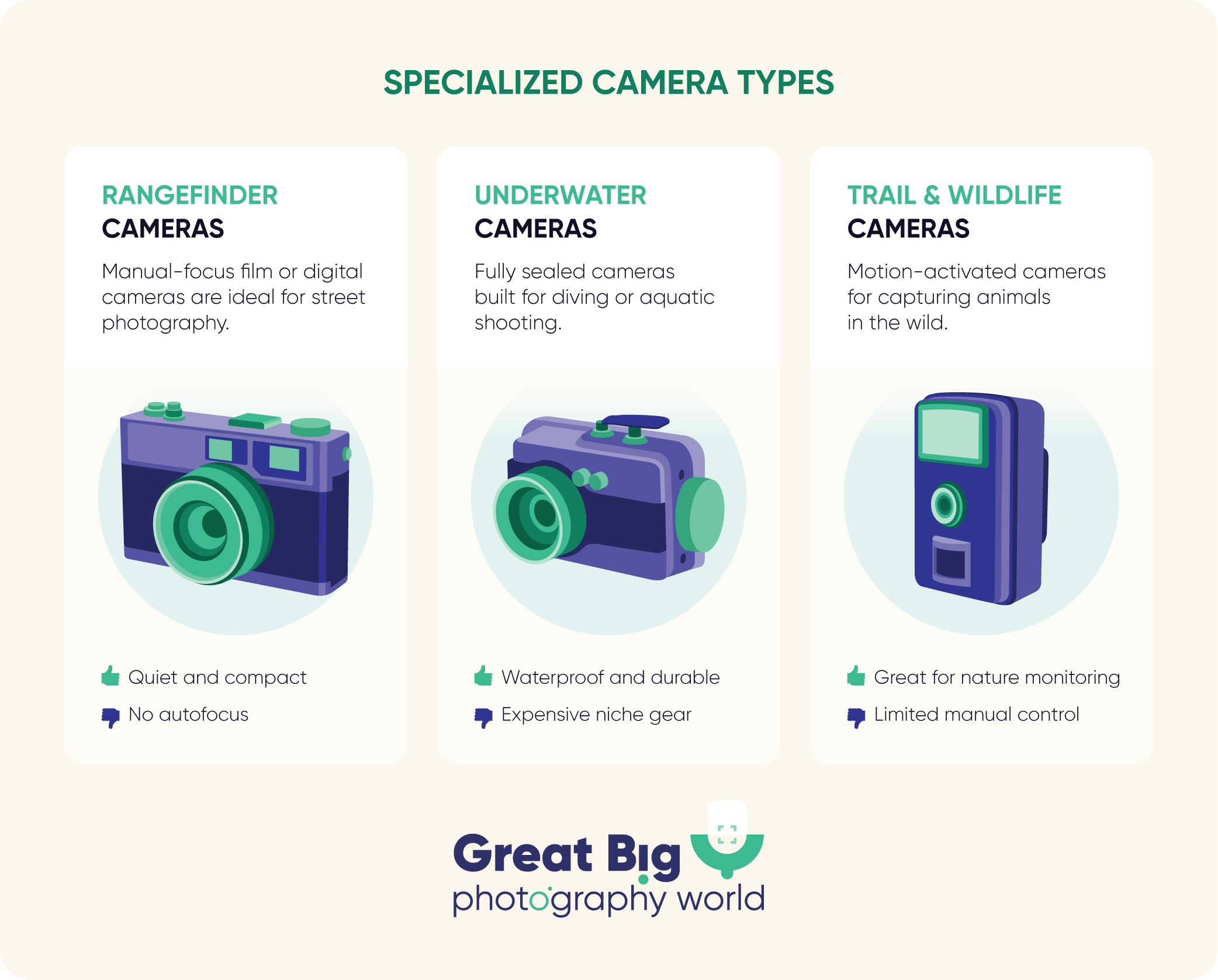
11. Rangefinder Cameras
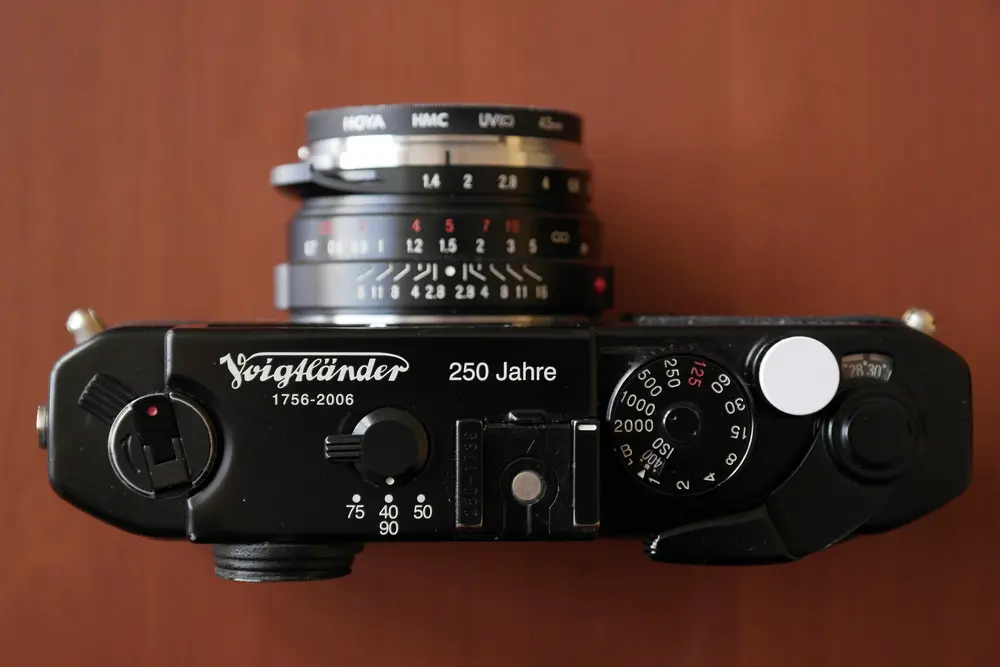
These cameras use a separate focusing system called a rangefinder, rather than mirrors or digital screens. They are compact and quiet, making them ideal for street and documentary photography. Leica M-series cameras are some of the most well-known examples.
Pros: Compact, sharp lenses, discreet
Cons: Manual focus, expensive, no zoom
12. Underwater Cameras
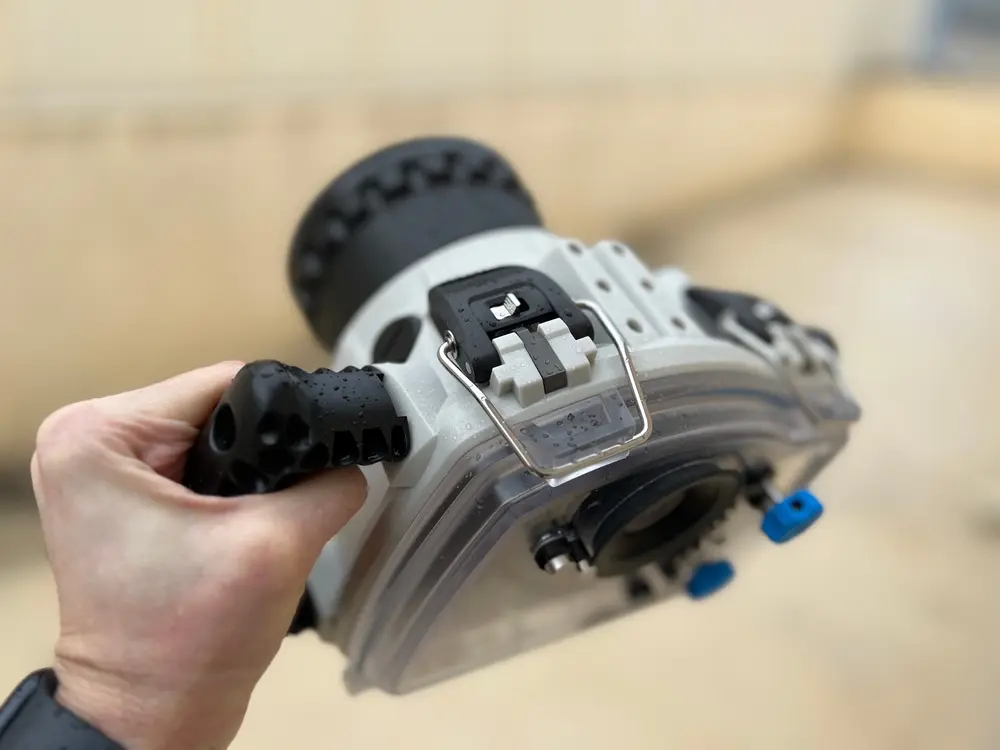
Specifically built for scuba diving or underwater shoots, these are waterproof and pressure-resistant without the need for an external case. Unlike action cams, they offer better optics and manual control.
Pros: Durable, high image quality underwater
Cons: Niche use case, expensive
13. Wildlife / Trail Cameras
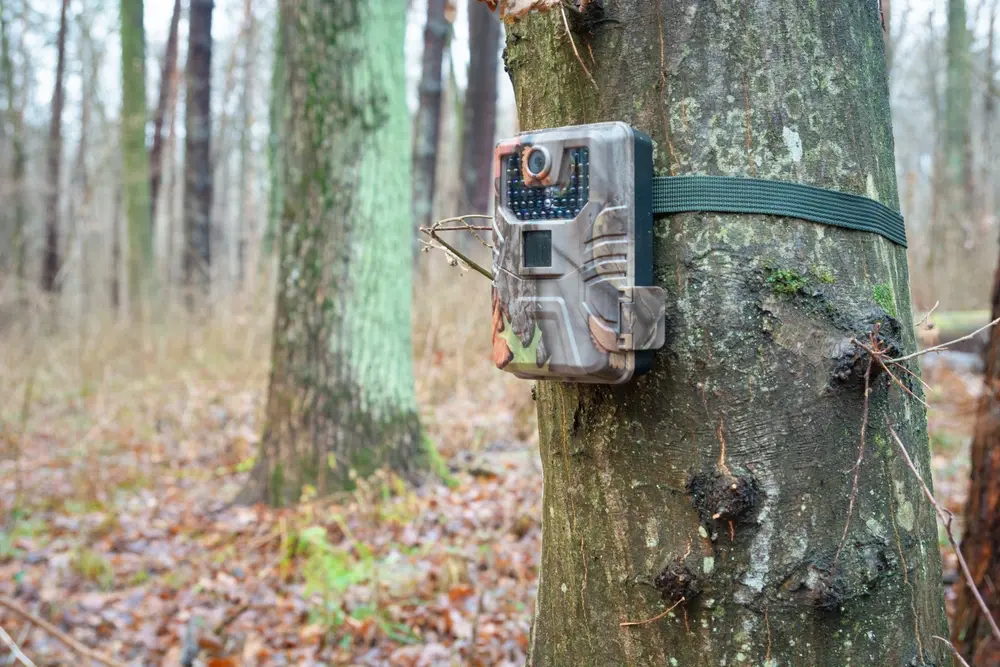
These are motion-activated or time-lapse cameras often used by scientists, conservationists, and hunters. They capture animals or activity without needing a photographer present.
Pros: Remote capture, weatherproof
Cons: Limited control, niche audience


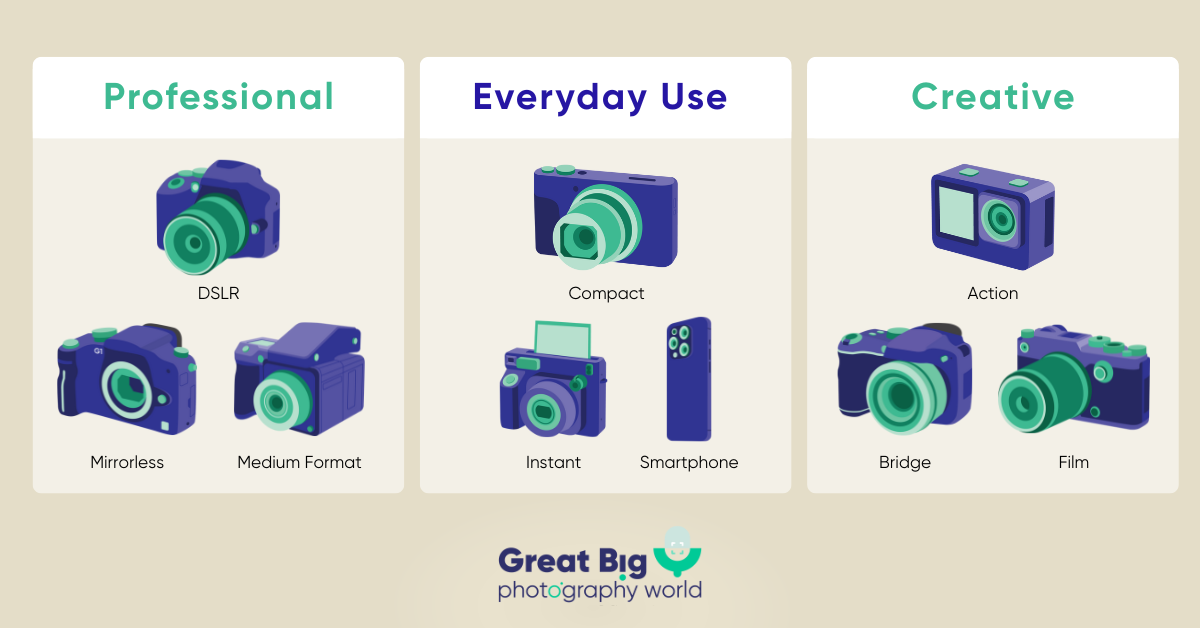

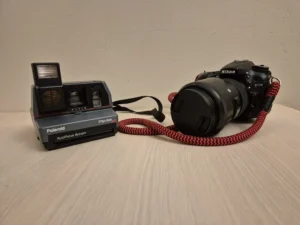





I really like the way tha you wrote the blog post reagarding cameras,it is very informative for us,thank you so much for sharing.
Thank you sooo much for spreading your knowledge for others to learn from. It made it easier for me to choose which camera I want to buy. I’ve narrowed it down to a DSLR or a Bridge Camera.
Very nicely explained.
Thanks Mr Kevin.
Thanks for the detailed explanation. Due to financial issues, my choice has been narrowed down to an action camera.
My journey is just getting interesting.